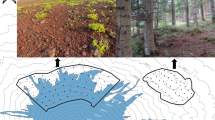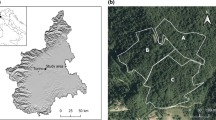Abstract
We studied the nutritional behaviour of hinds foraging on a mixed-forest edge by direct observation of their choices at each season and by measuring nutrient concentration in the plants. We compared nutrient concentrations in the observed diets with those in the total available vegetation, and with those of 1,000 randomly simulated diets in which we included only those plants that were actually eaten by the animal. Whether the available or the consumed feeds were used as the basis for comparisons had important consequences due to the presence of conifers and ferns, which were high in soluble sugars but were never eaten by the animals (potentially due to their toxicity). The selected diets were lower in sugars than the total available vegetation in summer, but were actually higher in sugars than the random diets generated from consumed forage species only. Hind diets contained more soluble sugars but not more protein than simulated diets in all seasons. Contrary to our prediction, anti-nutritional compounds (ADL and tannins) were avoided only in winter. Compared to simulated diets, hinds consumed more tannins in spring and summer and more ADL in summer and autumn. We suggest that this was a consequence of selection for soluble sugars, because the preferred plant species, which had high soluble sugar concentrations, also contained a large proportion of the anti-nutritional compounds eaten. In winter, the grass-dominated diets contained more fibre (NDF) and less ADL than the simulated diets, indicating that hinds orient their feeding towards digestible fibres. The switch from a browser to a grazer diet was related to a change in the availability of the nutrients, mainly soluble sugars. In our study, grasses contained more soluble sugars and proteins than deciduous browse during winter. This calls into question the dichotomy usually assumed in the literature between grass and browse in terms of nutrient content.


Similar content being viewed by others
References
AOAC (1990) Helrich K (ed) Official methods of analysis of the Association of Official Analytical Chemists, 15th edn. AOAC, Arlington, VA, pp 17–18
Austin PJ, Suchar LA, Robbins CT, Hagerman AE (1989) Tannin binding proteins in saliva of deer and their absence in saliva of sheep and cattle. J Chem Ecol 15:1135–1347
Bennett R, Wallsgrove RM (1994) Transley Review No. 72: Secondary metabolites in plant defence mechanisms. New Phytol 127:617–633
Berteaux D, Crete M, Huot J, Maltais J, Ouellet JP (1998) Food choice by white-tailed deer in relation to protein and energy content of the diet: a field experiment. Oecologia 115:84–92
Bugalho MN, Milne JA (2003) The composition of the diet of red deer (Cervus elaphus) in a Mediterranean environment: a case of summer nutritional constraint? For Ecol Manage 181:23–29
Clauss M, Lason K, Gehrke J, Lechner-Doll M, Fickel J, Grune T, Streich WJ (2003a) Captive roe deer (Capreolus capreolus) select for low amounts of tannic acid but not quebracho: fluctuation of preferences and potential benefits. Comp Biochem Physiol B 136:369–382
Clauss M, Lechner DM, Streich WJ (2003b) Ruminant diversification as an adaptation to the physicomechanical characteristics of forage. A reevaluation of an old debate and a new hypothesis. Oikos 102:253–262
Clutton-Brock TH, Albon SD (1989) Feeding behaviour and habitat use. In: Clutton-Brock TH, Albon SD (eds) Red deer in the Highlands. BSP Professional Books, Oxford
Codron D, Lee-Thorp JA, Sponheimer M, Codron J (2007) Nutritional content of savanna plant foods: implications for browser/grazer models of ungulate diversification. Eur J Wildl Res 53:100–111
Collins W, Urness PJ (1983) Feeding behavior and habitat selection of mule deer and elk on northern Utah summer range. J Wildl Manage 47:646–663
Dumont B, Renaud PC, Morellet N, Mallet C, Anglard F, Verheyden-Tixier H (2005) Seasonal variations of red deer selectivity on a mixed forest edge. Anim Res 54:369–381
Edge WD, Les Marcum C, Olson-Edge S (1988) Summer forage and feeding site selection by elk. J Wildl Manage 52:573–577
Gebczynska Z (1980) Food of the roe deer and red deer in the Bialowieza Primeval Forest. Acta Theriol 25:487–500
Gebert C, Verheyden-Tixier H (2001) Variations of diet composition of red deer (Cervus elaphus L.) in Europe. Mammal Rev 31:189–2010
Gonzalez-Hernandez MP, Silva-Pando FJ (1999) Nutritional attributes of understory plants known as components of deer diets. J Range Manage 52:132–138
Gordon IJ (2003) Browsing and grazing ruminants: are they different beasts? For Ecol Manage 181:13–21
Grover KE, Thompson MJ (1986) Factors influencing spring feeding site selection by elk in the Elkhorn Mountains, Montana. J Wildl Manage 50:466–470
Hagerman AE (1987) Radial diffusion method for determining tannin in plant extracts. J Chem Ecol 13:437–449
Hanley TA (1997) A nutritional view of understanding and complexity in the problem of diet selection by deer (Cervidae). Oikos 79:209–218
Hanley TA, Robbins CT, Hagerman AE, Mac Arthur C (1992) Predicting digestible protein and digestible dry matter in tannin containing forages consumed by ruminants. Ecology 73:537–541
Hobbs NT, Baker DL, Ellis JE, Swift DM (1979) Composition and quality of elk diets during winter and summer: a preliminary analysis. In: Boyce MS, Hayden-Wing LF (eds) North American elk: ecology. behavior and management. The University of Wyoming, Laramie, WY, pp 47–53
Hofmann RR (1989) Evolutionary steps of ecophysiological adaptation and diversification of ruminants: a comparative view of their digestive system. Oecologia 78:443–457
Homolka M, Heroldova M (2001) Native red deer and introduced chamois: foraging habits and competition in a subalpine meadow-spruce forest area. Folia Zool 50:89–98
Hudson RJ, Nietfeld HT (1985) Effects of forage depletion on the feeding rate of wapiti. J Range Manange 38:80–82
Hummel J, Südekum KH, Streich WJ, Clauss M (2006) Forage fermentation patterns and their implications for herbivore ingesta retention times. Func Ecol 20:989–1002
Jiang Z, Hudson RJ (1993) Optimal grazing of wapiti (Cervus elaphus) on grassland: patch and feeding station departure rules. Evol Ecol 7:488–498
Johnson DH (1980) The comparison of usage and availability measurements for evaluating resource preference. Ecology 61:65–71
Kamler J (2001) Morphological variability of forestomach mucosal membrane in red deer, fallow deer, roe deer and mouflon. Small Rumin Res 41:101–107
Komarek AR, Ankom Co, Fairport NY, Robertson JB, Van Soest PJ (1994) A comparison of methods for determining ADF using the filter bag technique versus conventional filtration. J Anim Sci 72(Suppl.1):114
Langvatn R, Hanley TA (1993) Feeding-patch choice by red deer in relation to foraging efficiency. An experiment. Oecologia 95:164–170
Laska M (2001) A comparison of food preferences and nutrient composition in captive squirrel monkeys, Saimiri sciureus, and pigtail macaques, Macaca nemestrina. Pysiol Behav 73:111–120
Latham J, Staines BW, Gorman ML (1999) Comparative feeding ecology of red (Cervus elaphus) and roe deer (Capreolus capreolus) in Scottish plantation forests. J Zool 247:409–418
Leslie DM, Starkey EE, Vavra M (1984) Elk and deer diets in old-growth forests in Western Washington. J Wildl Manage 48:762–775
Mould ED, Robbins CT (1981) Nitrogen metabolism in elk. J Wildl Manage 45:323–334
Mueller-Harvey I (2006) Unravelling the conundrum of tannins in animal nutrition and health. J Sci Food Agric 86:2010–2037
Parker KL, Gillingham MP (1993) An accurate technique for estimating forage intake of tractable animals. Can J Zool 71:1462–1465
Parsons AJ, Dumont B (2003) Spatial heterogeneity and grazing processes. Anim Res 52:161–179
Parsons MH, Lamont BB, Davies SJJF, Kovacs BR (2006) How energy and coavailable foods affect forage selection by the western grey kangaroo. Anim Behav 71:765–772
Renecker LA, Hudson RJ (1985) Estimation of dry matter intake of free-ranging moose. J Wildl Manage 49:785–792
Robbins CT (1993) Wildlife feeding and nutrition. Academic, New York
Robbins CT, Mole S, Hagerman AE, Hanley TA (1987) Role of tannins in defending plants against ruminants: reduction in dry matter digestion. Ecology 68:1606–1615
Said S, Pellerin ML, Guillon N, Fritz H (2005) Forage availability assessment for ecological studies of browsers in deciduous woodlands. Eur J Wildl Res 51:242–247
Shimada T (2006) Salivary protein as a defense against dietary tannins. J Chem Ecol 32:1149–1163
Somogyi M (1952) Notes on sugar determination. J Biol Chem 195:19–23
Staines BW, Crisp JM (1978) Observations on food quality in Scottish Red deer (Cervus elaphus) as determined by chemical analysis of the rumen contents. J Zool 185:253–277
SAS (1999) SAS/STAT user’s guide, v8. SAS Institute Inc., Cary, NC
Stewart DRM (1967) Analysis of plant epidermis in faeces : a technique for studying the food preferences of grazing herbivores. J Appl Ecol 4:83–111
Stolter C, Ball JP, Julkunen-Tiitto R, Lieberei R, Ganzhorn U (2005) Winter browsing of moose on two different willow species: food selection in relation to plant chemistry and plant response. Can J Zool 83:807–819
Tixier H, Duncan P, Scehovic J, Yani A, Gleizes M, Lila M (1997) Food selection by European roe deer (Capreolus capreolus): effects of plant chemistry, and consequences for the nutritional value of their diets. J Zool 242:229–245
Van de Veen HE (1979) Food selection and habitat use in the red deer (Cervus elaphus L.). Ph.D. thesis, Groningen University, Groningen, Holland, p 263
Van Soest PJ, Wine RH (1967) Use of detergents in the analysis of fibrous feeds, IV. Determination of plant cell-wall constituents. J Assoc Off Agri Chem 50:50–55
Van Wieren SE (1996) Do large herbivores select a diet that maximizes short-term energy intake rate? For Ecol Manage 88:149–156
Verheyden-Tixier H, Duncan P (2000) Selection for small amounts of hydrolysable tannins by a concentrate-selecting mammalian herbivore. J Chem Ecol 26:351–358
Wilmshurst JF, Fryxell JM (1995) Patch selection by red deer in relation to energy and protein intake: a re-evaluation of Langvatn and Hanley’s (1993) results. Oecologia 104:297–300
Wilmshurst JF, Fryxell JM, Hudson RJ (1995) Forage quality and patch choice by wapiti (Cervus elaphus). Behav Ecol 6:209–217
Acknowledgments
We thank the Ecology of Forests, Grasslands and Freshwater Department and the Animal Physiology and Livestock Systems Department of INRA for the thesis grant of P.-C. Renaud. M. Verdier from the INRA farm at Redon provided us with excellent research facilities. We are grateful to C. Mallet and F. Anglard for their observations of hind feeding behaviour and to N. Portas and D. Viala for tannin analyses. We also thank T. Daufresne and Mark Hewison for checking the English and providing comments on this manuscript. We are grateful to three anonymous reviewers for providing excellent suggestions for improving manuscript clarity. Our study complies with current French laws relating to animal experiments.
Author information
Authors and Affiliations
Corresponding author
Additional information
Communicated by Jean-Michel Gaillard.
Electronic supplementary material
Below is the link to the electronic supplementary material.
Rights and permissions
About this article
Cite this article
Verheyden-Tixier, H., Renaud, PC., Morellet, N. et al. Selection for nutrients by red deer hinds feeding on a mixed forest edge. Oecologia 156, 715–726 (2008). https://doi.org/10.1007/s00442-008-1020-3
Received:
Accepted:
Published:
Issue Date:
DOI: https://doi.org/10.1007/s00442-008-1020-3




